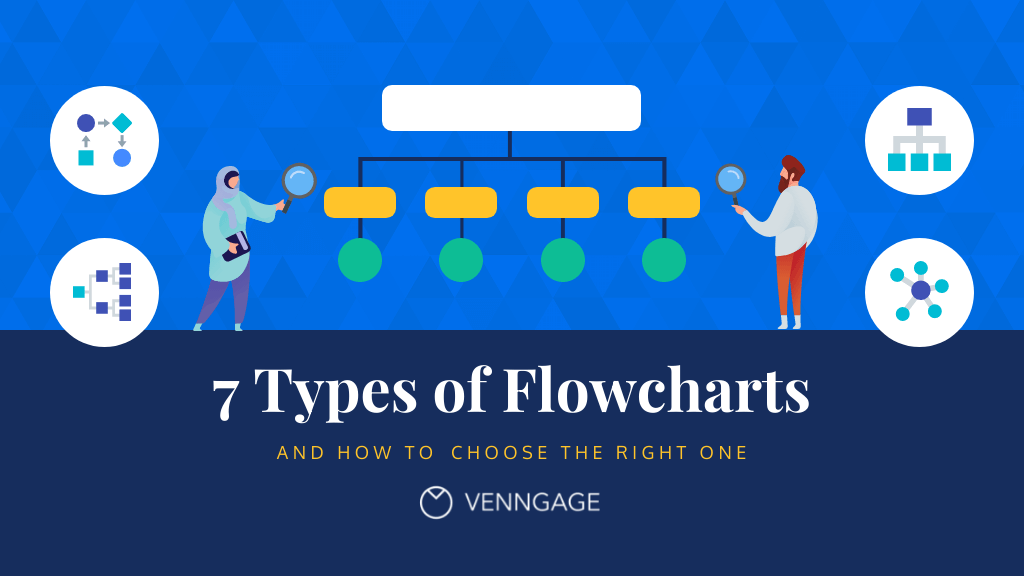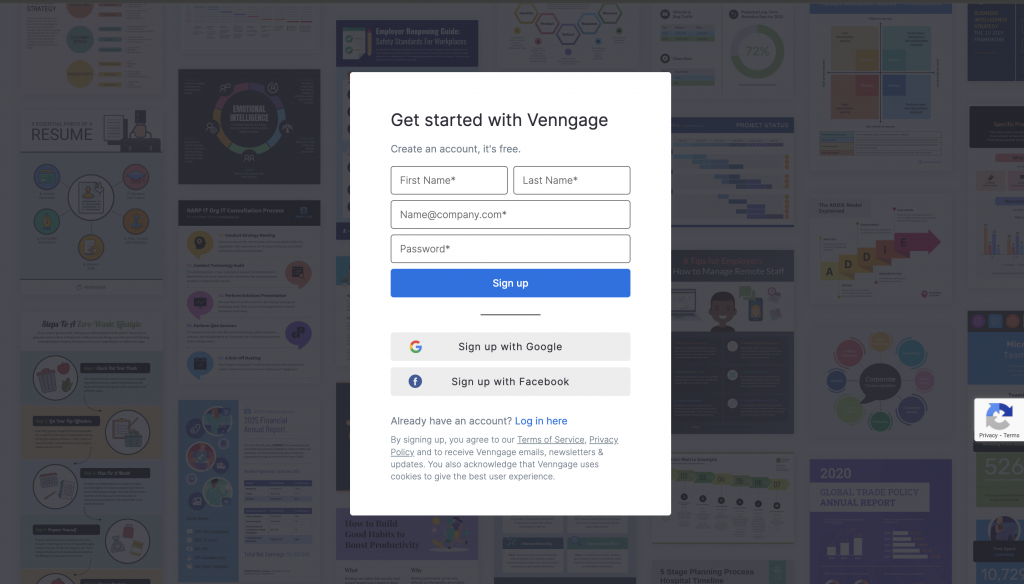
Flowcharts can be incredibly useful tools for visualizing business processes, procedures or systems, but picking the right type is tricky.
In this post, I’ll cover the different types of flowcharts and how you can choose the right one for your business needs.
If you’re looking to, Venngage’s Flowchart Maker makes the process simple and easy.
With just a few clicks, you can have a professional, effective flowchart to help with your business communications — no design experience is required.
But if you really want to speed up the flowchart creation process and not start from scratch, check out our extensive library of customizable flowchart templates.
Click to jump ahead:
What is a flowchart?
A flowchart is a diagram that illustrates a process, system or other sequential sets of steps.
Flowcharts are used extensively in computer programming, but they can also be a useful way to visualize an organization, a job task or a business process.
Organizations of all types can use flowcharts for both internal and external purposes.
Utilizing flowchart softwares can streamline the creation and editing of these diagrams, making the process more efficient and collaborative.
Here’s an example of an internal-focused flowchart.
This basic flowchart can help customer support team members understand the business process involved or what they need to do when there’s an email or their business phone rings.
But flowcharts can also be useful as a type of content companies create, such as this entertaining process flow diagram that helps readers understand whether a nap should be in their future.
For more flowchart examples, visit these posts:
- 21+ Flowchart Examples to Organize Projects and Improve Processes
- 20+ Flowchart Templates, Design Tips and Examples
Let’s take a look at the different types of flowcharts there are and how you can use the right one for your business communication needs.
8 types of flowcharts
You’ll often find the same type of flowcharts implemented regardless of the industry or task at hand.
Let’s take a look at each in this section.
- Process flowchart
- Decision flowchart
- Workflow flowchart
- Swimlane flowchart
- Use case flowchart
- EPC flowchart
- System or program flowchart
- Data or document flowchart
Read more: Flowcharts Symbols and Meaning
1. Process flowchart
A process flowchart shows the steps or actions involved in a process or workflow.
These diagrams use shapes and arrows to illustrate a sequence of activities and how they are interconnected.
Think of a process flowchart as a roadmap of a series of steps to complete a task or achieve a specific outcome. For instance, you can add this flowchart to explore customer retention strategies or your next marketing method.
Process flowcharts are commonly used to get a structured overview so that it’s easier to identify bottlenecks and inefficiencies.
In this example, a business is able to educate employees on the steps they must follow when receiving proposal requests from clients.
Another great example of when a process flowchart can be useful is onboarding new employees.
Having a rigid list of steps to follow not only helps new recruits settle in faster but also helps ensure the HR department stays organized and efficient.
2. Decision flowchart
Among the most immediately recognizable flowcharts, decision flowcharts are somewhat obvious in that they help make decisions.
Decision flowcharts include “yes” and “no” questions and answers as part of their flow.
Let’s take a look at some decision flowchart examples.
This decision flowchart is quite simple, but it is an ideal example of a format with questions that need to be asked and the order in which they should be posed.
This flowchart illustrates how a financial services organization handles customer information and what decisions team members need to make depending on the answers they get.
Another great example of decision flow charts is this template which illustrates a disciplinary process with all possible outcomes properly visualized, helping the reader follow the process easily.
This decision flowchart illustrates who has decision-making control in an emergency situation, but it could also easily be used to visualize a number of processes involving interdepartmental or cross-functional teams.
Or you canhelp team members understand their role in a broader process by customizing this account escalation process flowchart.
For more examples of decision flowcharts and decision trees, check out these blog posts:
- What is a Decision Tree and How to Make One
- 15+ Decision Tree Infographics to Visualize Problems and Make Better Decisions
3. Workflow flowchart / Workflow diagram
A workflow flowchart shows decisions and actions that happen inside an organization as part of a work product, project, service or other goals, like fulfilling a customer order.
They often show how different roles, teams or departments contribute to the product or service.
This workflow chart illustrates an IT troubleshooting process, but it’s easy to imagine how your organization could update it to help team members understand a process they are likely to repeat regularly.
A more basic flowchart example is this workflow diagram which helps you keep a lengthy project on track by visualizing the steps involved in completing it.
4. Swimlane flowchart
A swimlane flowchart is a type of workflow diagram that is always cross-functional and illustrates the order in which decisions or actions happen and the relationships between them.
Phases of the workflow are usually read from left to right or top to bottom, and distinct teams are displayed in rows or columns.
This is a good example of this type of cross-functional flowchart:
This swimlane flowchart is a good way to illustrate a complex process in your company that covers data or documents that may enter your organization through a few means but that need to be handled the same way.
5. Use case flowchart / Use case diagram
A use case diagram or use case flowchart illustrates the goals and interactions a customer has with a company, and it can include both external customers and internal users.
One of its main purposes is to show the interactions between the company and external customers.
This use-case flowchart template isolates major events involved in managing customer relationships, but it could easily apply to any event-based process flowchart that involves multiple organizational levels.
This use-case diagram shows the possible ways in which an ATM could be used but it could also be customized to visualize an event-driven process in your company.
Diagrams like this can be useful when considering making major process changes or adding/removing equipment.
Related: 10+ Types of Diagrams and How to Choose the Right One
6. EDP flowchart / EPC diagram
An event-driven process or EDP flowchart (also called an EPC diagram, with EPC standing for event-driven process chain) is similar to a use case flowchart or diagram in that it focuses on customers or users.
But where EDP flowcharts are unique is that they narrow their focus on actions taken by users, which are often illustrated as “events” in the context of a process.
This EPC diagram illustrates the steps involved in an e-commerce purchase, from the time a customer creates a cart on the website to its pickup being scheduled.
7. System flowchart or program flowchart
System flowcharts and program flowcharts describe how systems and programs function and interact.
Some show processes and functions completed by computer systems, while others show how manual, paper, online, and disk drives interact as part of a process, such as how paper applications get input into databases that can then be accessed online.
This is a good example of a system flowchart, although it’s in the form of an infographic.
This particular program flowchart illustrates how a payment program processes customer information and finalizes payments.
Related: 28 Process Infographic Templates and Visualization Tips
8. Data flow diagram or document flowchart
Data flowcharts (also called data flow diagrams) and document flowcharts illustrate how information and data flow within a system.
Sometimes information is in documents, though the data in question can also reside within a database or other structure.
This is an example of what a data flowchart looks like:
This data flow diagram describes how data flows within a business process when a customer starts placing an order. Although it’s more of a basic flowchart, the data flow diagram still manages to map all the fundamental stages where the data goes through.
For more details on business process mapping, read our blog post: How to Diagram a Business Process [Process Diagramming Templates]
When to use flowcharts
Phew, that’s a lot of flowcharts.
By now, you must have realized how versatile flowcharts are and how they can be used in different industries for various decision-making scenarios.
But, how can you be absolutely certain you need a flowchart?
If you’re faced with any of the following six scenarios, a flowchart is the answer.
- Document a process
Want to make sure everyone understands complex processes such as an operational workflow, manufacturing process, or software development cycle? Use a flowchart! - Analyze and improve a process
If you want to ensure optimal use of resources, flowcharts are great tools to pinpoint specific areas that require improvement. - Plan projects
If you’re running a complex project, a flowchart can be a great way to visualize the overall structure and identify the steps involved. - Make decisions
When a project requires critical thinking or active decision-making, a flowchart can help visualize different decision points and potential outcomes. - Train staff
By breaking down processes into clear steps, flowcharts provide an easy-to-follow guide to train staff on how to execute tasks. - Solve problems
If you’re facing some issues in a process, flowcharts are an effective method to identify potential causes, guide troubleshooting efforts, and create effective solutions.
Feel free to check out how problem-solving flowcharts can be extremally beneficial for you and your business with our guide.
How do I make a flowchart with Venngage?
Venngage’s Flowchart Maker is simple and easy to use.
Within 5 simple steps, you can create a dazzling and functional flowchart to map business processes, organize your team and keep your projects on track. No design experience required.
Step 1: Sign up for a free Venngage account
You can sign up with your email, Gmail or Facebook account.

Step 2: Select a template from our library
Besides the ones we’ve shared above, we offer hundreds of other flowchart templates that are easy to edit even if you have no design skills.

Step 3: Start editing your flowchart
Most of our templates are created with the simple drag-and-drop editor that lets you design in minutes, even if you have no design skills.
You can add, edit, delete or drag nodes, texts, and icons around in one click and the node will automatically adjust to whatever content you add to it as well.

Step 4: Liven up your flowchart with icons, illustrations and branding elements
We offer over 40,000 icons and illustrations for you to visualize any information you want on your flowchart.
If you upgrade to a Business account, you can enjoy My Brand Kit—the one-click branding kit that lets you upload your logo and apply brand colors and fonts to any design.

Step 5: Share a public link for free or upgrade to download
Once you upgrade, you can download your flowchart in PNG, PDF or PowerPoint format—if you want to use it for your presentation.

Map your business workflows with stunning flowcharts on Venngage
Whether you want to help your team members visualize and memorize a new business process, make a crucial executive decision or engage your audience with an entertaining visual, the various types of flowcharts available with Venngage should suit all your needs.
Choose the right flowchart type that fits your business communication needs and start creating one today, using our various detailed flowchart templates and smart diagram editor.





















































